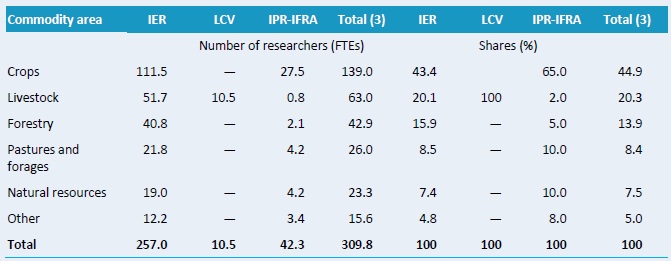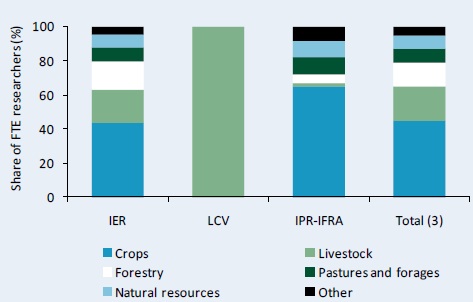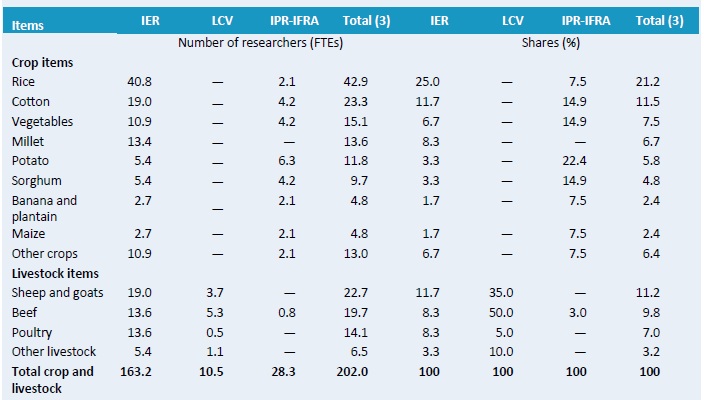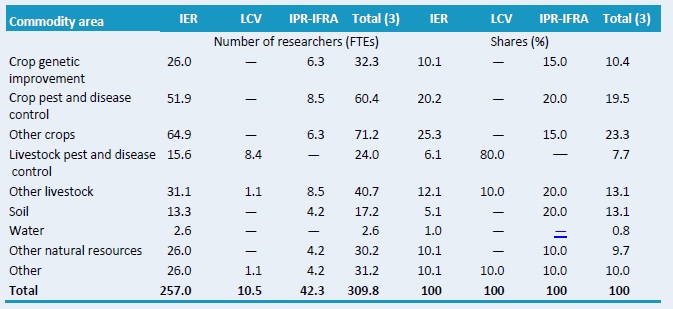The ASTI Data in Focus series provides additional background data in support of the 2010 Country Note on Mali (asti.cgiar.org/pdf/Mali-Note.pdf) prepared by the Agricultural Science and Technology Indicators (ASTI) initiative and the Rural Economy Institute (IER). Based on data collected by ASTI and IER, these two outputs review major investment and capacity trends in Mali's public agricultural research and development (R&D) since 1981, providing important updates on agricultural R&D trends prepared by ASTI and IER in 2003–04.
D. Research Allocation across Commodities and Themes
This section provides detailed quantitative information on Mali's public agricultural research allocation in 2008. Complementary sections present detailed data on long–term trends (Section A), financial resources (Section B), and human resources (Section C). Further supporting information provides macroeconomic trends, a list of agencies included in the study, data sources and estimation procedures, and ASTI's methodology.
Table D1–Research focus by major commodity area, 2008
In 2008, 139 of Mali's 310 full–time equivalent (FTE) researchers for which research focus data were available were involved in crop research. Of the remaining researchers, 63 focused on livestock, 43 focused on forestry, 26 focused on pastures and forages, and 23 focused on natural resources. The category labeled "other" includes researchers involved in fisheries research or working on socioeconomic and post–harvest issues.

Source: Calculated by authors from ASTI–IER 2009–10.
Note: Data for Higher Institute of Training and Applied Research (ISFRA) were unavailable.
Figure D1–Research focus by major commodity area, 2008
This figure presents the allocation of FTE researchers across different commodity areas (see also Table D1). In 2008, 45 percent of Mali's agricultural researchers were involved in crop research. An additional 21 percent focused on livestock research, 15 percent on forestry research, 8 percent on pastures and fodder, and 8 percent on natural resources.

Source: Calculated by authors from ASTI–IER 2009–10.
Note: Data for Higher Institute of Training and Applied Research (ISFRA) were unavailable.
Table D2–Focus of crop and livestock research by major item, 2008
In 2008, rice research accounted for 21 percent of all resources allocated to crop and livestock research. Other important crops were cotton (12 percent), vegetables (8 percent), millet (7 percent), potatoes (6 percent), and sorghum (5 percent). The principal livestock commodities are sheep and goats (11 percent), beef (10 percent) and poultry (7 percent).

Source: Calculated by authors from ASTI–IER 2009–10.
Note: Data for Higher Institute of Training and Applied Research (ISFRA) were unavailable.
Table D3–Focus of crop and livestock research by major theme, 2008
This table presents FTE researchers by thematic area in absolute and relative terms. Crop–related themes are the most important in Mali, accounting for 164 of the 310 FTE researchers employed in 2008 at the three–agency sample for which thematic focus data were available. That year, 10 percent of Mali's agricultural researchers focused on crop genetic improvement, 20 percent focused on crop pest and disease control, and another 23 percent focused on other research related to crops. Livestock research was another important area, accounting for 21 percent of the country's agricultural researchers.

Source: Calculated by authors from ASTI–IER 2009–10.
Note: Data for Higher Institute of Training and Applied Research (ISFRA) were unavailable..
Copyright (C) 2011 International Food Policy Research Institute and Rural Economy Institute. Sections of this Data in Focus issue may be reproduced without the express permission of, but with acknowledgement to IFPRI and IER. This series is an output of the ASTI initiative and has not been peer reviewed. Any opinions stated herein are those of ASTI and do not necessarily reflect the policies and opinions of IFPRI or IER.
